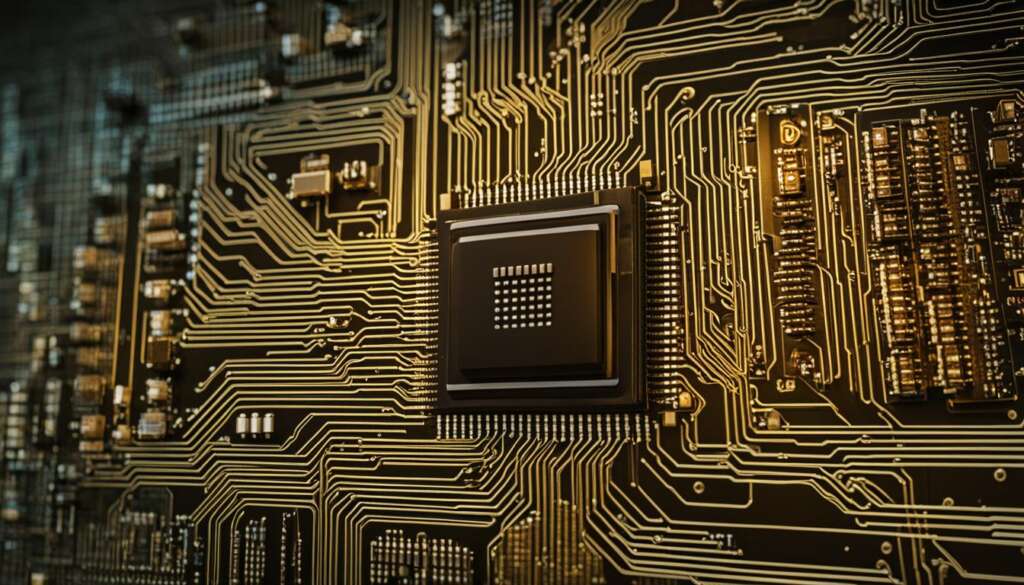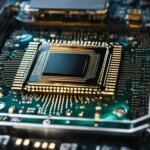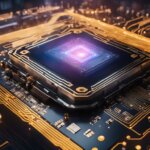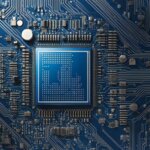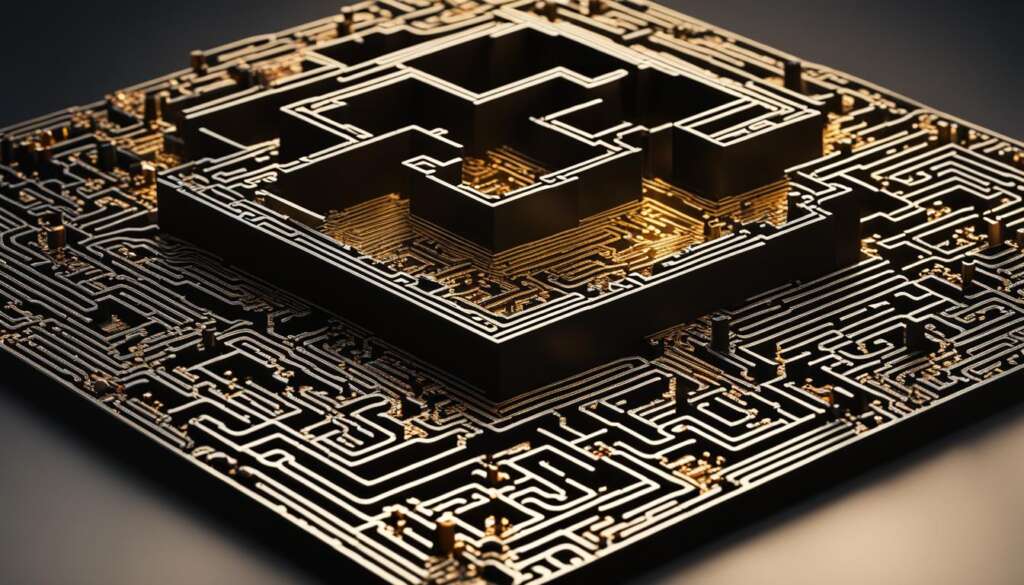Table of Contents
Microprocessors in consumer electronics have brought about a remarkable transformation in our world. These tiny, powerful chips have had a profound impact, revolutionizing the way we interact with technology. From smartphones and laptops to smart home devices and wearables, microprocessors have become the backbone of modern consumer electronics.
The impact of microprocessors on consumer electronics cannot be overstated. The continuous advancement in microprocessor technology has enabled the integration of powerful computing capabilities into smaller and sleeker devices. This has opened up a world of possibilities and convenience for consumers, making our lives more connected, efficient, and enjoyable.
Microprocessors have not only made consumer electronics more powerful but also more accessible. The affordability and availability of electronic devices have increased as microprocessors have become cheaper and more efficient. This has allowed a wider range of people to enjoy the benefits of modern technology.
As we delve deeper into the impact of microprocessors on consumer electronics, we will explore the evolution of microprocessors, the different types of microprocessors, their key features, advantages, and limitations. Join us on this exciting journey as we uncover the remarkable influence of microprocessor technology on the modern world of consumer electronics.
The Evolution of Microprocessors
The evolution of microprocessors has played a crucial role in shaping modern consumer electronics. From their humble beginnings in the 1970s to the powerful processors we have today, microprocessors have continuously improved in size, speed, and capabilities, driving innovation in the consumer electronics industry.
The first-generation microprocessors, such as the Intel 4004 and 8008, paved the way for future advancements by introducing 4-bit and 8-bit processing capabilities. As technology progressed, subsequent generations brought forth 16-bit and 32-bit microprocessors, enabling more complex computations and superior performance. Today, we have 64-bit processors like the Intel Core series, which deliver unprecedented computing power for a wide range of applications.
The significance of the evolution of microprocessors cannot be overstated. Their progress has enabled the integration of powerful computing capabilities into various consumer electronic devices, from smartphones and tablets to smart TVs and wearable devices. As microprocessors continue to evolve, we can expect even more impressive advancements in consumer electronics, pushing the boundaries of what is possible in terms of functionality, performance, and connectivity.

In summary, the evolution of microprocessors has been instrumental in the development of modern consumer electronics. From the early days of 4-bit processors to the current 64-bit powerhouses, microprocessors have transformed the capabilities of consumer devices, making them faster, smaller, and more versatile. The continuous evolution of microprocessor technology promises exciting possibilities for the future, as consumer electronics become even more integrated into our daily lives.
Types of Microprocessors
Microprocessors come in various types, each designed for specific purposes. Understanding the different types can help us appreciate the vast capabilities of these powerful computing components.
Complex Instruction Set Microprocessors (CISC)
CISC microprocessors are known for their ability to handle complex mathematical calculations. They optimize program size by minimizing the number of instructions required, making them ideal for applications that involve extensive computational tasks.
Reduced Instruction Set Microprocessors (RISC)
RISC microprocessors prioritize execution time by using simplified instruction sets. They excel at quickly executing simple instructions, which makes them efficient for applications that require fast processing, such as real-time systems or embedded systems.
Superscalar Microprocessors
Superscalar microprocessors are capable of executing multiple instructions simultaneously, significantly enhancing processing speed. They are commonly used in arithmetic logic units (ALUs) and multipliers, where parallel processing is essential.
Application-Specific Integrated Circuits (ASICs)
ASICs are microprocessors designed for specific applications or functions. They provide optimized performance for a particular task, such as digital signal processing or encryption. ASICs offer a high level of customization and efficiency, catering to the unique requirements of specialized applications.
Digital Signal Multiprocessors (DSPs)
DSPs are microprocessors specifically designed for signal conversion and processing. They excel at handling real-time data streams and are commonly used in devices like RADAR and SONAR systems. DSPs provide the computational power necessary for complex signal analysis and manipulation.
| Microprocessor Type | Main Features | Common Applications |
|---|---|---|
| Complex Instruction Set Microprocessors (CISC) | Minimize number of instructions per program, perform complex mathematical calculations | Mainframes, data centers, scientific research |
| Reduced Instruction Set Microprocessors (RISC) | Optimize execution time, use simplified instruction sets | Embedded systems, mobile devices, network routers |
| Superscalar Microprocessors | Perform multiple tasks simultaneously, enable parallel processing | Arithmetic logic units (ALUs), multipliers, high-performance computing |
| Application-Specific Integrated Circuits (ASICs) | Customizable for specific applications, optimized performance | Digital signal processing, encryption, specialized applications |
| Digital Signal Multiprocessors (DSPs) | Designed for signal conversion, real-time data streams | RADAR systems, SONAR systems, audio processing |
Key Features of Microprocessors
The modern microprocessors used in consumer electronics come equipped with a range of powerful features that enhance their performance and functionality. These features have revolutionized the way we interact with electronic devices, enabling faster speeds, improved multitasking capabilities, and enhanced graphics processing. Let’s explore some of the key features that make microprocessors a crucial component in modern consumer electronics.
Clock Speed
The clock speed of a microprocessor determines the rate at which it can execute instructions. It is measured in gigahertz (GHz). The higher the clock speed, the faster the microprocessor can process data. A higher clock speed allows for quick and efficient execution of tasks, resulting in smoother and more responsive user experiences.
Instruction Set Architecture
The instruction set architecture (ISA) of a microprocessor defines the set of instructions it can execute and the way it operates. Different microprocessors may have different ISAs, each optimized for specific tasks. The ISA affects the efficiency and complexity of processing, influencing the performance and capabilities of the microprocessor.
Cache Memory
Cache memory is a type of memory that stores frequently accessed data, allowing for quicker access and retrieval. Microprocessors have built-in cache memory that improves the overall speed and efficiency of data processing. The size and organization of the cache memory play a crucial role in determining the microprocessor’s performance.
Multi-core Processors
Modern microprocessors often feature multiple cores, which enable parallel processing and improve multitasking capabilities. Each core can execute instructions independently, allowing for more efficient distribution of tasks across the processor. Multi-core processors enhance the overall performance and responsiveness of consumer electronic devices.
Virtualization
Virtualization technology allows a single microprocessor to run multiple operating systems simultaneously. This feature is particularly useful in devices like smartphones, tablets, and laptops, where users often require different operating systems for various tasks. Virtualization enables seamless switching between different software environments, enhancing flexibility and usability.
Power Management
Microprocessors incorporate power management features to optimize energy consumption. These features help reduce power usage when the processor is idle or operating at lower capacity, extending the battery life of mobile devices and reducing electricity consumption for stationary devices, contributing to a more sustainable and eco-friendly approach to technology.
Graphics Processing
Many microprocessors include integrated graphics processing units (GPUs) that are specifically designed for handling graphics-intensive tasks. These GPUs enhance the visual experience by enabling smooth rendering of high-resolution images, videos, and games. Graphics processing capabilities are particularly important in devices such as gaming consoles, smartphones, and smart TVs.
Security Features
Microprocessors often incorporate advanced security features to protect against malware, hacking, and unauthorized access. These features include encryption algorithms, secure boot processes, and hardware-based security mechanisms. By ensuring the integrity and confidentiality of data, microprocessors enhance the overall security of consumer electronic devices.
Internet Connectivity
Microprocessors play a crucial role in enabling internet connectivity in consumer electronic devices. They support various wireless communication protocols such as Wi-Fi, Bluetooth, and cellular networks, allowing users to stay connected wherever they go. Internet connectivity has become an essential feature of modern consumer electronics, enabling seamless access to online services and content.
Machine Learning Capabilities
Some microprocessors incorporate specialized units that accelerate machine learning tasks. These units, known as neural processing units (NPUs) or tensor processing units (TPUs), can perform complex calculations required for tasks such as speech recognition, image processing, and natural language processing. Machine learning capabilities enable devices to learn and improve over time, providing personalized and intelligent experiences to users.
| Feature | Description |
|---|---|
| Clock Speed | The rate at which a microprocessor executes instructions |
| Instruction Set Architecture | The set of instructions and operations the microprocessor can perform |
| Cache Memory | High-speed memory that stores frequently accessed data |
| Multi-core Processors | Microprocessors with multiple independent processing units |
| Virtualization | Ability to run multiple operating systems simultaneously |
| Power Management | Optimization of energy consumption for prolonged battery life |
| Graphics Processing | Specialized units for rendering high-quality graphics |
| Security Features | Built-in mechanisms to protect against threats and unauthorized access |
| Internet Connectivity | Support for wireless communication protocols |
| Machine Learning Capabilities | Specialized units for advanced artificial intelligence tasks |
Advantages of Microprocessors
Microprocessors have revolutionized modern consumer electronics, offering numerous advantages that have transformed the way we live and interact with technology. One of the key advantages of microprocessors is their high processing speed. With advanced architectures and increased clock speeds, microprocessors can handle complex tasks and execute instructions quickly and efficiently, ensuring seamless performance in various applications.
Another advantage of microprocessors is their compact size. These powerful chips can be integrated into small electronic devices without compromising on performance. From smartphones to wearable devices, microprocessors enable the creation of sleek and portable gadgets that can easily fit into our pockets or be worn on our wrists.
In terms of maintenance, microprocessors are relatively easy to maintain compared to other computing components. They are designed to be durable and reliable, requiring minimal troubleshooting or repairs. This ease of maintenance ensures that consumer electronics powered by microprocessors have longer lifespans and provide a hassle-free user experience.
| Advantages of Microprocessors |
|---|
| High processing speed |
| Compact size |
| Easy maintenance |
| Capability for complex mathematics |
| Flexibility for customization |
| Improvement based on specific requirements |
Microprocessors also excel at handling complex mathematics. With their powerful computational capabilities, microprocessors can perform intricate calculations, enabling advanced applications such as artificial intelligence, data analysis, and scientific simulations. From crunching numbers to running complex algorithms, microprocessors play a vital role in various industries.
Flexibility is another advantage of microprocessors. These versatile chips can be customized and programmed to meet specific requirements. Whether it’s adjusting clock speeds, optimizing power consumption, or integrating additional features, microprocessors provide flexibility for manufacturers to tailor their products to different market needs.
In conclusion, microprocessors offer a multitude of advantages that have revolutionized consumer electronics. From their high processing speed and compact size to easy maintenance and flexibility, microprocessors have paved the way for powerful, portable, and customizable devices. As technology continues to advance, we can expect microprocessors to further improve and shape the future of consumer electronics.
The Disadvantages of Microprocessors in Consumer Electronics
The use of microprocessors in consumer electronics has undoubtedly revolutionized the technological landscape. However, it is important to acknowledge that these powerful computing components also come with certain disadvantages that can impact their performance and functionality.
One of the primary concerns with microprocessors is the issue of overheating. As these processors handle complex computing tasks, they generate a significant amount of heat, which, if not properly addressed, can lead to performance issues and even damage to the device. Adequate cooling solutions, such as heat sinks and fans, are necessary to mitigate this risk and ensure the optimal functioning of microprocessors.
Another limitation of microprocessors is their performance dependence on the size of the data being processed. While microprocessors excel at handling large amounts of data, their efficiency can be affected when dealing with smaller data sets. This can result in suboptimal performance and slower execution of tasks. It is therefore important to consider the data requirements of the intended application when selecting a microprocessor for consumer electronics.
Performance Dependent on Data Size
MICROPROCESSOR PERFORMANCE COMPARISON
| Microprocessor Model | Data Size | Performance |
|---|---|---|
| Microprocessor A | Large | High |
| Microprocessor B | Small | Medium |
| Microprocessor C | Large | Low |
Additionally, microprocessors typically require larger board sizes compared to their counterparts, such as microcontrollers. This can pose challenges in terms of board space limitations when designing compact consumer electronic devices. Engineers and designers must carefully consider the size constraints and make efficient use of available space to accommodate microprocessors.
Furthermore, some microprocessors have limited support for floating-point operations, which can impact certain computational tasks that require precision and accuracy. It is crucial to evaluate the specific requirements of the intended application and select a microprocessor that offers the necessary support for floating-point operations, if required.
Despite these limitations, the advantages of microprocessors in consumer electronics far outweigh their disadvantages. The continuous advancements in microprocessor technology, coupled with careful consideration of these drawbacks, allow for the development of innovative and powerful electronic devices that enhance our daily lives.
The Transformation of Computing
The evolution of microprocessors has ushered in a transformative era for computing. From the early days of cumbersome mainframes to the sleek and powerful devices we use today, microprocessors have played a crucial role in shaping the way we interact with technology. The impact of microprocessors on computing cannot be overstated, as they have paved the way for personal computing, expanded the range of devices available, and revolutionized user interfaces.
The role of microprocessors in enabling personal computing cannot be understated. With the introduction of microprocessors into personal computers, computing power became accessible and affordable to the masses. These miniaturized yet powerful processors provided the foundation for the development of desktops, laptops, and tablets, enabling individuals to have their own computing devices at home, in the office, or on the go.
Furthermore, microprocessors have been instrumental in the expansion of devices and user interfaces. As microprocessors evolved, they became smaller, faster, and more energy-efficient, allowing for their integration into a variety of devices beyond traditional computers. Smartphones, smartwatches, gaming consoles, and even home appliances now rely on microprocessors to deliver advanced functionalities and intuitive user interfaces. The expansion of devices and user interfaces has made computing an integral part of our daily lives, empowering us to connect, communicate, and accomplish tasks with unprecedented ease.
The Future of Computing
The transformation of computing driven by microprocessors is far from over. As technology continues to advance, we can expect even more impressive developments in the field of consumer electronics. The integration of artificial intelligence, machine learning, and Internet of Things (IoT) capabilities with microprocessors is already shaping the future of technology. From voice-activated assistants to autonomous vehicles, the possibilities seem limitless.
Overall, the impact of microprocessors on computing has been nothing short of revolutionary. These tiny yet mighty processors have democratized technology, expanded the range of devices available, and refined user interfaces. As we continue to ride the wave of technological innovation, it is worth appreciating the pivotal role that microprocessors have played in transforming computing, and eagerly anticipate the exciting advancements yet to come.
Conclusion
The evolution of microprocessors has had a profound impact on the development of modern consumer electronics. From the invention of the first microprocessor to the current generation of advanced processors, microprocessors have enabled the integration of powerful computing capabilities into various consumer electronic devices.
Thanks to microprocessor technology, consumer electronics have become faster, smarter, and more versatile. The continuous advancements in microprocessors have not only made devices more efficient but have also opened up new possibilities for innovation and functionality. As a result, we now have smartphones that can perform complex tasks, smart TVs that provide immersive entertainment experiences, and wearable devices that track our health and fitness.
Looking ahead, the evolution of microprocessors is set to continue driving the evolution of consumer electronics. With each new generation of microprocessors, we can expect even higher levels of performance, energy efficiency, and connectivity. This will further expand the range of devices and applications that can benefit from the power of microprocessors, shaping the future of technology and enhancing our daily lives.
FAQ
How have microprocessors influenced modern consumer electronics?
Microprocessors have had a profound impact on modern consumer electronics by enabling the integration of powerful computing capabilities into various devices, revolutionizing their accessibility, affordability, and connectivity.
What is the evolution of microprocessors?
The evolution of microprocessors can be traced through different generations, each bringing advancements in size, clock speed, number of transistors, and instructions per second, culminating in the current 64-bit processors.
What are the types of microprocessors?
There are several types of microprocessors, including Complex Instruction Set Microprocessors (CISC), Reduced Instruction Set Microprocessors (RISC), Superscalar microprocessors, Application-specific integrated circuits (ASICs), and Digital signal multiprocessors (DSPs).
What are the key features of microprocessors?
Microprocessors come with a range of features, including clock speed, instruction set architecture, cache memory, multi-core processors, virtualization, power management, graphics processing units (GPUs), security features, internet connectivity options, and specialized units for machine learning tasks.
What are the advantages of microprocessors in consumer electronics?
Microprocessors provide high processing speeds, compact size, easy maintenance, the ability to perform complex mathematical calculations, flexibility for customization and improvement, and a wide range of applications.
What are the disadvantages of microprocessors?
Some limitations of microprocessors include overheating with prolonged use, performance being affected by data size, the requirement for larger board sizes compared to microcontrollers, and limited support for floating-point operations.
How have microprocessors transformed computing?
The integration of microprocessors into personal computers (PCs) revolutionized the accessibility and affordability of computing devices, and they have since enabled the development of portable devices with customizable interfaces, leading to widespread connectivity.
Source Links
- https://www.geeksforgeeks.org/evolution-of-microprocessors/
- https://www.ncbi.nlm.nih.gov/pmc/articles/PMC5378251/
- https://www.byjusfutureschool.com/blog/how-microprocessors-have-changed-the-history-of-computing/
- https://pcsite.co.uk/the-birth-of-the-microprocessor-a-historical-perspective/


